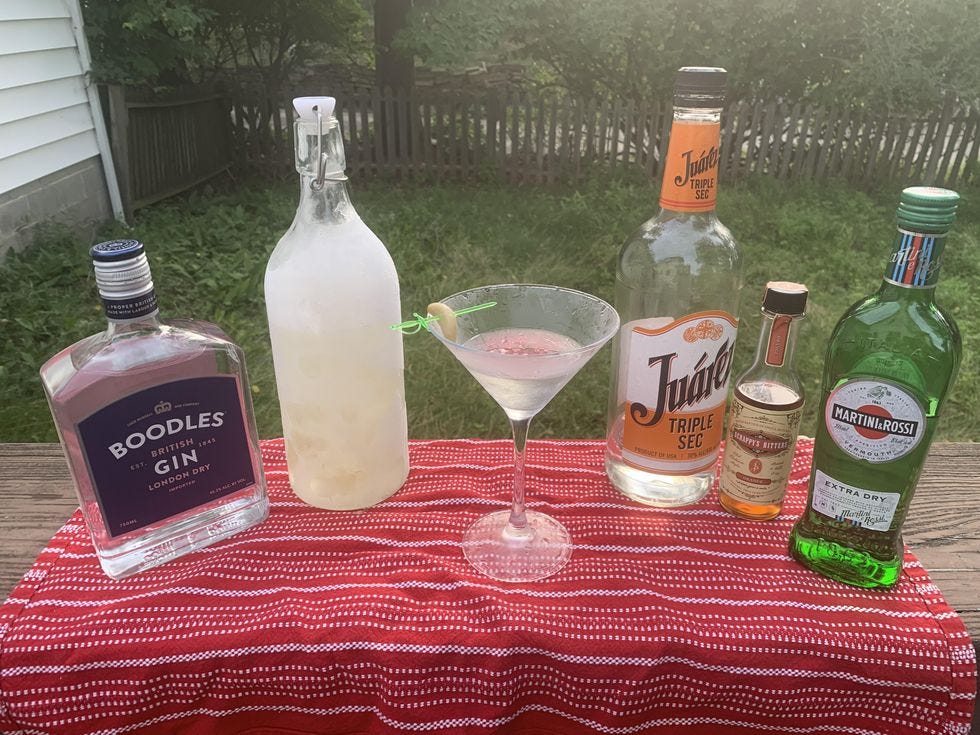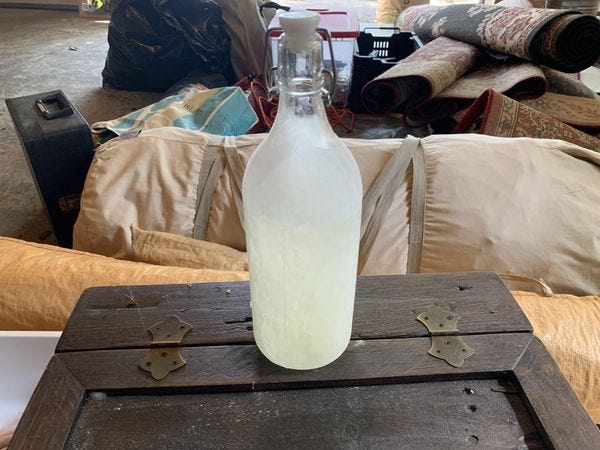Welcome To Wonkette Happy Hour, With This Week's Cocktail, Freezer Martinis!
The coldest martini you will ever have, bar none.
Greetings, Wonketeers! I’m Hooper, your bartender. By the time you’re reading this, I’m on vacation! I’m camping out at Pennsic, the hugest SCA event ever, finally back after three years of hiatus. I am hanging out in tents doing medieval things with a bunch of friends, and one of them wanted to try martinis for the first time. So let’s make a week’s worth of martinis all at once! Here’s the recipe.
Freezer Martinis
20 oz Boodles Gin
5 oz distilled water
4 oz Martini & Rossi Dry Vermouth
8 dashes orange bitters
2 oz triple sec
5-6 inches lemon twist
Using a funnel, add all ingredients to a stoppered bottle. Seal and place in a freezer 1-2 days minimum. To serve, pour into a chilled martini glass and garnish with a lemon twist or other garnish. Recipe makes 5-6 martinis.
Martinis are one of the most iconic cocktails ever created, and one of the most horribly abused. The classic martinis savored by Don Draper and the Rat Pack were simple, artfully composed two-ingredient drinks. A classic London Dry gin, like Bombay Sapphire; a tart dry vermouth, like Martini and Rossi. Done. Maybe a dash of orange bitters, with a lemon twist. Maybe a cocktail sword, with one or three olives (never two, an even number is bad luck), and a splash of olive brine. That’s all you need to be one of the cool crowd.
I still serve a few classic martinis like this, but the fans of the classic are dwindling. These days, a martini often means a cold glass of vodka, or a sweet dessert drink in a martini glass. I’m completely guilty of making and enjoying the latter. I’ve had requests for an “Ovaltini'' as a nightcap for my Pennsic campmates. But the decadent smoothness of an herbal, complex martini seems to be falling by the wayside.
Fortunately, a dear friend asked me to make him a martini or two over the course of Pennsic . I’m happily obliging by making up five or six at one go. Making a whole bottle’s worth of martinis at once provides several advantages.
First, a cocktail that’s made entirely of spirits can stay chilled for weeks without degrading in flavor. If anything, a bottle of martinis that’s been left to sit gets smoother and mellower. The gin and vermouth melt into each other. It’s also ridiculously convenient. No stirring. No measuring. Just hold up your glass, and the martini is there for the taking. Keeping your martinis in the fridge makes them very, very cold, far colder than one stirred with ice. Last, making a cocktail in a batch allows you to add ingredients that are too small to measure in single glass servings. It is a decadent and simple way to enjoy a martini. I’m a huge fan.
Let’s talk ingredients:

Matthew Hooper
Boodles London Dry Gin: This is my favorite “classic” gin. Clean, crisp, affordable, and not too heavy on the juniper. A more citrus-forward gin would also make a killer martini. I’d recommend Tanqueray Rangpur Lime as a choice, or even Hendricks if you’re in the mood for something delicate and floral. Remember that we’re making an extremely cold cocktail. Low temperatures can shut off subtle flavors in a drink. I’d avoid using fragile monsters like The Botanist.
Martini & Rossi Dry Vermouth: It’s not expensive, and there are richer vermouths out there. But Martini & Rossi is iconic for the American martini. If I’m making my first martini, or introducing someone to martinis, I would want to start here. Keep your vermouth in the fridge after you open it. It’s wine, not liquor. After a few days at room temperature, vermouth gets nasty.
Triple sec: I’m using a touch of sweet orange flavor to lighten and sweeten this martini. I prefer a citrus martini over a briny one. Dirty martinis and their cousins have their place, but I wouldn’t want my first martini to be a big shot of alcoholic pickle juice. By working in large proportions, I can put manageable amounts of subtler ingredients into a martini. Anything under ½ oz in a cocktail is difficult to measure.
If you prefer a savory, briny, “dirty” martini, I’d replace the triple sec with your favorite pickle or olive brine. Use a freshly opened jar of pickled treats. Old brine can get nasty. I have an urge to toss in a tiny amount of Islay scotch, no more than an ounce. The smokiness would boost the olive brine nicely. Mezcal might achieve the same effect.
Orange bitters: I’ve seen many professional bartenders add orange bitters to their martinis. It gives some lighter citrus and herbal notes to the cocktail. In this batch, it leans into the triple sec and lends some badly needed complexity. For a savory martini, I’d add half as many dashes ofhellfire tincture — no more than four. Spicy cocktails work, but caution is in order.
Water: I’m adding water to the bottle to replace the meltwater from stirring a martini over ice. Use the best water you can get your hands on. I use aBrita pitcher for my drinking water, but use whatever works for you. If your freezer is super cold, you will see flakes of ice in the bottle. Those will melt quickly, and won’t damage the martini.
Garnish and service: I’ve added a very long lemon twist to this bottle. Scott Sauer of Crafted Cocktail taught me how to cut these a lifetime ago, and I’m still a big fan. The lemon oil will help this citrus-forward martini stick the landing.
If you add olives to your bottled martini, they will probably freeze into little ice bombs in the bottom of your cocktail. This might actually be awesome, if the idea of frozen olives on a hot day appeals to you. Just make sure to add an odd number of olives. An even number of olives in your martini is bad luck — even by the bottle.
In summary and conclusion, drink well, drink often, and tip your bartender — donate to Wonkette at the link below! And if you'd like to buy some bar gear or books from Amazon, please click here!
OPEN THREAD!




lol That's an actual Thing???
I skipped the Cheney story to quickly trip in to this one. Mmmmmm. Can I use a 5 quart Igloo?